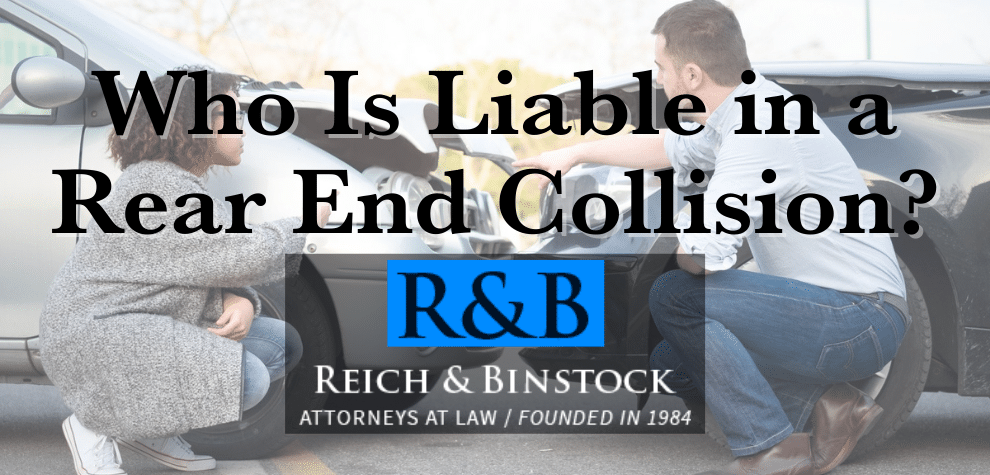Car accidents are scary and stressful enough. When you have to worry about assigning liability to calculate damages in a rear end collision, things get even more complicated. With the help of an experienced attorney, however, it is possible to simplify the process significantly. At Reich & Binstock, we prioritize the rights of our clients above all else. We offer aggressive and compassionate representation to car accident and personal injury victims across the state of Texas. To schedule a free consultation with us, please call 713-622-7271 or fill out our online intake form.
Who Is Liable in a Rear End Collision?
In the majority of rear end collisions, the motorist in the back is at fault. In a rear end collision, however, the rear motorist is not automatically at fault. The lead driver or another vehicle may cause a rear end collision.
In a vehicle collision, determining who is to blame is critical since it decides who is responsible for the other driver’s damages. Finding out if a motorist was careless and what percentage of the accident happened from the driver’s negligence might help establish liability.
In an automobile accident, negligence shows by failing to drive safely or by breaking a traffic statute or rule, such as the ones listed below.
- Texting while driving
- Driving while distracted (for example, driving while listening to music or with headphones)
- Speeding
- Tailgating
Plaintiffs who suffered injuries can file a personal injury lawsuit to seek compensation for their losses. After an accident, drivers and passengers wounded in a rear-end collision can claim compensation for their injuries. The following are some of the most common types of damages.
- Current and future medical expenses
- Lost wages and earnings
- Pain and suffering
- Property damage costs
- Loss of consortium
- Wrongful death costs for survivors
Is Fault Automatic in a Rear End Collision?
In a rear end collision, fault is not assigned automatically. While the back driver is frequently to blame for following too closely or driving while inattentive, the lead driver can also be to blame. A rear end collision might also be caused by another vehicle, a pedestrian, or even poor road conditions.
The majority of automobile accidents are caused by carelessness. The negligent party is responsible for any injuries and losses caused to others under negligence rules. A careless driver is responsible to any wounded drivers or passengers in a rear end traffic incident.
Injury victims must typically prove that the defendant was negligent in order to collect damages following an accident. The following are the components of carelessness that must be demonstrated.
- The defendant in the case owes the victim a duty of care.
- They breached that duty of care by exercising negligence.
- Their negligence led to causing the injuries or death of the victim.
While we drive, the basic standard of care that we owe other drivers includes the following.
- Exercising a reasonable amount of caution while driving
- Watching for pedestrians, obstacles in the road, and other vehicles
- Controlling the speed and movement of the vehicle while driving
Failing to exercise reasonable care is considered negligence.
When Is the Front Driver at Fault in a Rear End Collision?
The majority of rear end collisions are caused by the rear motorist following too closely for the circumstances or failing to provide enough space to safely stop. In a rear end collision, however, the leading motorist may be at fault. If the lead driver does not drive with reasonable care, he or she may be held responsible for any damages.
In a rear-end collision, the lead motorist may be to blame due to careless or reckless driving, which may include the following.
- Pulling out in front of other cars
- Sudden stopping
- Reversing into another car
- Road rage
- Intentionally trying to cause an accident
- Driving while under the influence
- Driving without working tail lights
Who Is at Fault if the Front Driver Brakes Suddenly?
A typical cause of rear-end collisions is a driver suddenly braking, forcing the rear driver to collide with the car ahead. A rear driver may blame the front driver for braking unexpectedly, yet the rear driver may still be at fault for the collision.
There is no set following distance that is considered safe. The safe following distance is determined by the current road conditions. A motorist, for example, may need to change the following distance based on a variety of variables.
- Driving at night
- Wet road conditions
- Heavy vehicle weights
- Traffic that frequently stops and starts
- Loose rocks or gravel on the road
- Soft brakes
Distracted drivers, in addition to drivers following too closely, cause rear-end incidents. A rear motorist may argue that the lead driver suddenly braked, but the rear driver was not paying attention to the road at the moment. When the motorist glances up, the automobile in front of them may have slowed or stopped.
Who Is Liable When a Driver Pulls in Front of You Suddenly and Gets Hit?
When a motorist suddenly pulls out in front of another car and is hit, determining who is at fault can be difficult. Both the motorist who pulls out unexpectedly and the driver who fails to stop in time may be to blame for the collision. This is dependent on the precise circumstances of the accident, such as the following.
- Speed of the vehicle
- Conditions of the road
- Failing to signal before turning or changing lanes
- Traffic signals
- Lane markings
- Various other factors
The trailing driver may be held responsible for the collision if he or she is not driving safely, including speeding. The motorist who was rear-ended may be held responsible for the collision if the other car merges into moving traffic across several lanes without indicating or breaches a solid yellow line.
What About Multiple Vehicle Rear End Accidents?
Multiple automobiles are involved in many rear-end collisions. This includes “chain reaction” rear-end crashes, in which a vehicle in the rear collides with another vehicle, which then collides with the vehicle in front, and so on. During multi-vehicle collisions, the automobiles that caused the collision are frequently blamed for the damage. In a multi-car rear-end collision, however, numerous drivers may be held responsible.
In rare instances, none of the drivers involved in a rear-end collision may be held responsible for the accident. The following factors may contribute to a rear-end collision in whole or in part.
- Other reckless drivers
- Manufacturers of vehicle brakes
- Dangerous road conditions
- Animals or people running into the street
- Cyclists or pedestrians
When numerous people suffer in a rear end collision, determining who is at fault can be difficult. It’s possible that those involved have differing perspectives on what happened and who was to blame. In a motor vehicle accident case, a jury will frequently decide on negligence and responsibility.
Damages in a Rear End Collision Lawsuit
Any expenditures or losses incurred as a result of the accident go into the damages in a rear end collision. This covers both monetary and non-monetary compensation. The following are examples of compensatory damages in a vehicle accident.
- Current and future medical expenses
- Hospital and emergency room treatments
- Physical and/or occupational therapy
- Medications
- Medical supplies
- Lost wages
- Lost earning capacity
- Loss of consortium
- Scarring or disfigurement
- Pain and suffering
Punitive damages may be available if the accident involves criminal activity or irresponsible driving, such as a DUI that resulted in harm.
If I’m Partly to Blame, Can I Still File a Lawsuit?
Texas is a state with “comparative faults.” This implies that even if you were somewhat to blame for the accident, you may be able to collect damages. The parties involved may share fault under Texas’s comparative fault legislation. Based on the amount of fault of the other parties, the injured person may claim damages.
For example, if two drivers were involved in a rear end collision, the jury might rule on who was at fault. Driver A is found to be 20% at fault for the collision, whereas Driver B is found to be 80% at fault. Based on comparative blame, Driver A might collect 80% of the losses from Driver B.
Do I Need an Attorney After a Rear End Collision if It Wasn’t My Fault?
Many drivers believe they can handle an accident claim on their own or will delegate it to their vehicle insurance provider. It’s critical to know the insurance adjuster’s job and who the adjuster works for. The insurance firm receives motivation from a desire to save money and pay out as little as possible.
The insurance company may try to deny the claim or prolong the resolution process in the hopes that the wounded motorist would eventually give up and take whatever compensation is provided. Consult a skilled Houston personal injury lawyer before accepting the insurance company’s low-ball settlement offer.
Experienced rear end collision accident lawyers are familiar with the insurance companies’ tactics and how to combat them. Our team of compassionate Houston personal injury attorneys, automobile accident detectives, and medical specialists will go through all of the facts in your case to ensure that you receive the compensation you deserve following an accident.
What If I Was Hit by an Uninsured Driver?
Uninsured and underinsured motorist coverage is a type of optional insurance that compensates for damages caused by another driver who is one of the following.
- Does not have car insurance
- Their policy does not offer enough coverage to pay for the damages
Although insurance firms must provide these plans, it is not a requirement to acquire uninsured motorist coverage.
Even if a motorist has insurance, the liability limitations in a major rear-end collision may not be adequate to pay the losses. If another driver suffers injuries in a major accident, he or she may use his or her uninsured motorist insurance to compensate for losses that do not receive coverage from the other driver’s policy.
If an injured party does not have this insurance, the types of damages they may claim have limitations. A personal injury lawsuit against the at-fault motorist is an option for other parties. If the at-fault driver does not have insurance, however, there is a good possibility that he or she does not have a lot of financial assets to compensate for the damages in the event of an accident.
Contact Reich & Binstock Today
To get in touch with qualified representatives for your case, please contact Reich & Binstock today. We represent a wide array of personal injury and multidistrict litigation cases. Don’t hesitate to call us at 713-622-7271 or fill out our online intake form. The longer you wait, the more difficult it is to obtain compensation for your case.














